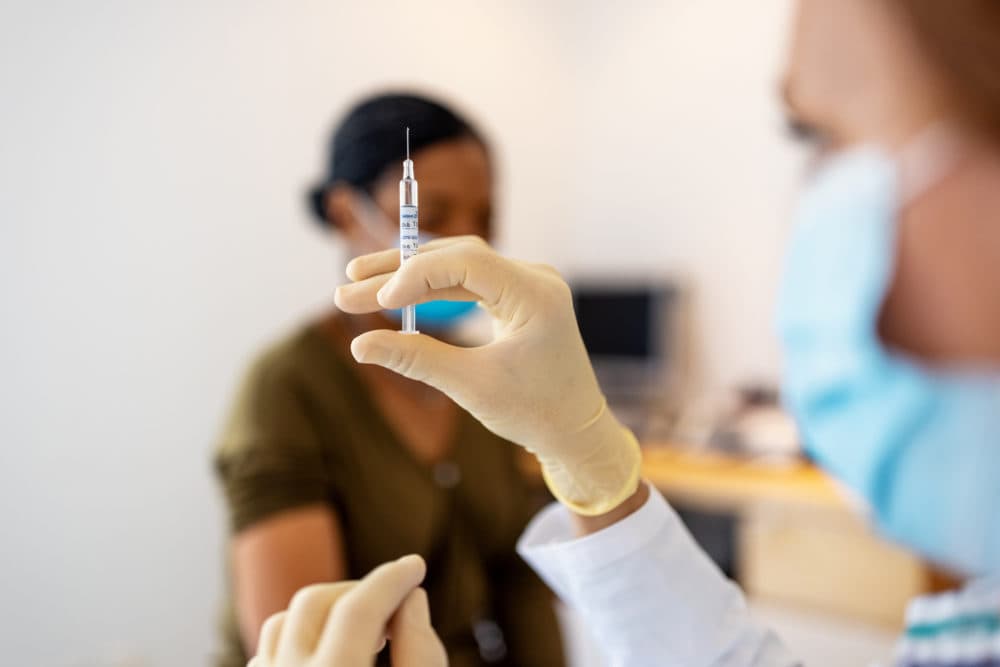Advertisement
Coronavirus Coverage
Vaccine hesitancy or lack of access? New study examines racial gaps in COVID vaccination rates

Almost as soon as the COVID vaccine rollout began, there were signs of racial and ethnic disparities in vaccination rates. Some attributed this to vaccine hesitancy. Others pointed to lack of access as the culprit. A large new study, published in the journal "Nature Communications," suggests both played a role, but barriers to access were more significant in the U.S. than in the U.K.
Comparing results from more than 1.3 million people who took part in the smartphone-based COVID Symptom Study, researchers found that minority participants in the U.K. and the U.S. had similar levels of vaccine hesitancy in the early stages of the vaccination effort. On both sides of the Atlantic, for example, Black respondents were three times more likely to be vaccine hesitant than white individuals.
However, among those willing to get the vaccine, researchers found that Black participants in the U.S. were 30% less likely to become vaccinated than white subjects. No similar gap was found in the U.K.
“There was definitely a double whammy effect in the U.S.,” said Andrew Chan, the director of epidemiology at the Massachusetts General Hospital Cancer Center and an author of the study. “I think it's difficult for us to fully disentangle the contributions of vaccine hesitancy from vaccine access to the lower rates of vaccination in the early phases of the vaccine campaign. Clearly, both factors played a role.”
Chan said a likely explanation for differences between the U.K. and U.S. lies in the vaccine rollout. The U.K. relied on a centralized distribution system, which was possible because of the country's National Health Service.
"Our data suggest that it’s not a lost cause — that we really can do better."
Andrew Chan, MGH Cancer Center
In contrast, the U.S. relied on a more fragmented approach, with different strategies pursued in different states, counties and even neighboring communities.
Juxtaposing the two vaccination programs provides some insight into what might improve long-term disparities, Chan said. He suggests having primary care physicians be more actively involved in discussions around vaccination might be an important strategy.
“Our data suggest that it’s not a lost cause — that we really can do better,” Chan said.
In the U.S. overall, vaccination gaps have been eliminated for white and Hispanic residents but remain for Black residents. According to the Kaiser Family Foundation, data from January shows 61% percent of white Americans have been vaccinated, compared with 62% of Hispanic Americans and 55% of Black Americans.
In Massachusetts, one of the most highly vaccinated states, data continued to show racial disparities. The report found 86% of white individuals in Massachusetts were vaccinated compared to 80% of Black individuals and 76% of Hispanic individuals.
Asian individuals were more likely to be vaccinated both nationally and in Massachusetts, where the rate was as high as 98%.
Public health experts responding to the study said it provides important context about disparities in vaccination rates at the same time that efforts continue to vaccinate and boost more people against COVID-19.
“I was really glad to see an international comparison,” said Monica Wang, a professor at Boston University’s School of Public Health and an associate director at the Center for Antiracist Research, who was not involved in the study. “What this says is that racial inequities in vaccine uptake don't have to be the default.”
Richard Ellison, a professor at the UMass Chan Medical School and the hospital epidemiologist at UMass Medical Center, who also was not involved in the study, said he was not surprised to see high levels of vaccine hesitancy. He argues that messaging around the development of the vaccine contributed to the uncertainty.
“The 'warp speed' analogy really was counterproductive," Ellison said.
"Many people feel that people cut corners and didn't do all of the safety analysis.”
Ellison argues that in some ways, these are the most studied vaccines in history.
"We can't go out and say we have safety over 10 years because we don't have that," Ellison said. "But the other information about the safety and efficacy over the course of the first year, we know far more about this than we do about any other vaccine.
